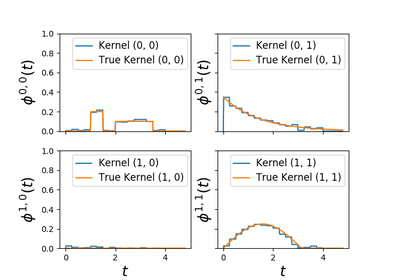tick.hawkes.HawkesEM¶
-
class
tick.hawkes.HawkesEM(kernel_support=None, kernel_size=10, kernel_discretization=None, tol=1e-05, max_iter=100, print_every=10, record_every=10, verbose=False, n_threads=1)[source]¶ This class is used for performing non parametric estimation of multi-dimensional Hawkes processes based on expectation maximization algorithm.
Hawkes processes are point processes defined by the intensity:
\[\forall i \in [1 \dots D], \quad \lambda_i = \mu_i + \sum_{j=1}^D \int \phi_{ij} dN_j\]where
\(D\) is the number of nodes
\(\mu_i\) are the baseline intensities
\(\phi_{ij}\) are the kernels
- Parameters
kernel_support :
float, default=`None`The support size common to all the kernels. Might be
Noneifkernel_discretizationis setkernel_size :
int, default=10Number of discretizations of the kernel
kernel_discretization :
np.ndarray, default=NoneExplicit discretization of the kernel. If set, it will override
kernel_supportandkernel_sizevalues.tol :
float, default=1e-5The tolerance of the solver (iterations stop when the stopping criterion is below it). If not reached the solver does
max_iteriterationsmax_iter :
int, default=100Maximum number of iterations of the solver
verbose :
bool, default=FalseIf
True, we verbose things, otherwise the solver does not print anything (but records information in history anyway)print_every :
int, default=10Print history information when
n_iter(iteration number) is a multiple ofprint_everyrecord_every :
int, default=10Record history information when
n_iter(iteration number) is a multiple ofrecord_everyn_threads :
int, default=1Number of threads used for parallel computation.
if
int <= 0: the number of physical cores available on the CPUotherwise the desired number of threads
- Attributes
n_nodes :
intNumber of nodes of the estimated Hawkes process
n_realizations :
intNumber of given realizations
kernel :
np.arrayshape=(n_nodes, n_nodes, kernel_size)The estimated kernels
baseline :
np.arrayshape=(n_nodes)The estimated baseline
References
Lewis, E., & Mohler, G. (2011). A nonparametric EM algorithm for multiscale Hawkes processes. preprint, 1-16.
The n-dimensional extension of this algorithm can be found in the latex documentation.
-
__init__(kernel_support=None, kernel_size=10, kernel_discretization=None, tol=1e-05, max_iter=100, print_every=10, record_every=10, verbose=False, n_threads=1)[source]¶ Initialize self. See help(type(self)) for accurate signature.
-
fit(events, end_times=None, baseline_start=None, kernel_start=None)[source]¶ Fit the model according to the given training data.
- Parameters
events :
listoflistofnp.ndarrayList of Hawkes processes realizations. Each realization of the Hawkes process is a list of n_node for each component of the Hawkes. Namely
events[i][j]contains a one-dimensionalnumpy.arrayof the events’ timestamps of component j of realization i. If only one realization is given, it will be wrapped into a listend_times :
np.ndarrayorfloat, default = NoneList of end time of all hawkes processes that will be given to the model. If None, it will be set to each realization’s latest time. If only one realization is provided, then a float can be given.
baseline_start :
Noneornp.ndarray, shape=(n_nodes), default=NoneUsed to force start values for baseline parameter If
Nonestarts with uniform 1 valueskernel_start :
Noneornp.ndarray, shape=(n_nodes, n_nodes, kernel_size), default=NoneUsed to force start values for kernel parameter If
Nonestarts with random values
-
get_history(key=None)¶ Returns history of the solver
- Parameters
key :
str, default=NoneIf
Noneall history is returned as adictIf
str, name of the history element to retrieve
- Returns
output :
listordictIf
keyis None orkeyis not in history then output is a dict containing history of all keysIf
keyis the name of an element in the history, output is alistcontaining the history of this element
-
get_kernel_norms()[source]¶ Computes kernel norms. This makes our learner compliant with
tick.plot.plot_hawkes_kernel_normsAPI- Returns
norms :
np.ndarray, shape=(n_nodes, n_nodes)2d array in which each entry i, j corresponds to the norm of kernel i, j
-
get_kernel_supports()[source]¶ Computes kernel support. This makes our learner compliant with
tick.plot.plot_hawkes_kernelsAPI- Returns
output :
np.ndarray, shape=(n_nodes, n_nodes)2d array in which each entry i, j corresponds to the support of kernel i, j
-
get_kernel_values(i, j, abscissa_array)[source]¶ Computes value of the specified kernel on given time values. This makes our learner compliant with
tick.plot.plot_hawkes_kernelsAPI- Parameters
i :
intFirst index of the kernel
j :
intSecond index of the kernel
abscissa_array :
np.ndarray, shape=(n_points, )1d array containing all the times at which this kernel will computes it value
- Returns
output :
np.ndarray, shape=(n_points, )1d array containing the values of the specified kernels at the given times.
-
objective(coeffs, loss: float = None)[source]¶ Compute the objective minimized by the solver at
coeffs- Parameters
coeffs :
numpy.ndarray, shape=(n_coeffs,)The objective is computed at this point
loss :
float, default=`None`Gives the value of the loss if already known (allows to avoid its computation in some cases)
- Returns
output :
floatValue of the objective at given
coeffs
-
score(events=None, end_times=None, baseline=None, kernel=None)[source]¶ Compute score metric Score metric is log likelihood (the higher the better)
- Parameters
events :
listoflistofnp.ndarray, default = NoneList of Hawkes processes realizations used to measure score. Each realization of the Hawkes process is a list of n_node for each component of the Hawkes. Namely
events[i][j]contains a one-dimensionalnumpy.arrayof the events’ timestamps of component j of realization i. If only one realization is given, it will be wrapped into a list If None, events given while fitting model will be usedend_times :
np.ndarrayorfloat, default = NoneList of end time of all hawkes processes used to measure score. If None, it will be set to each realization’s latest time. If only one realization is provided, then a float can be given.
baseline :
np.ndarray, shape=(n_nodes, ), default = NoneBaseline vector for which the score is measured If
Nonebaseline obtained during fitting is usedkernel :
Noneornp.ndarray, shape=(n_nodes, n_nodes, kernel_size), default=NoneUsed to force start values for kernel parameter If
Nonekernel obtained during fitting is used- Returns
likelihood :
doubleComputed log likelihood value
